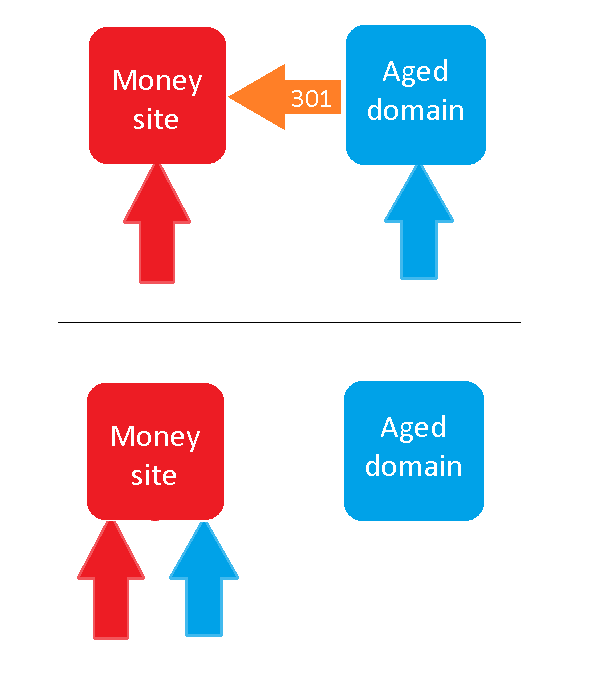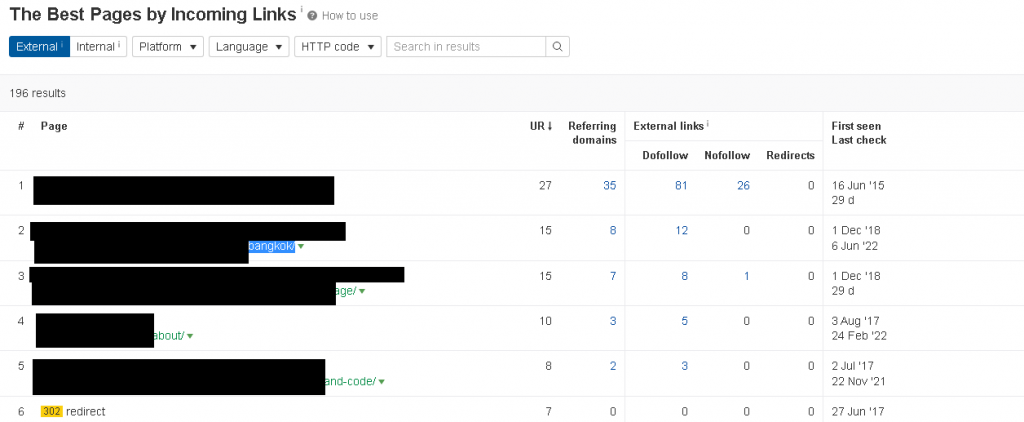For years, black-hat SEOs have been using aged domains in order to create PBNs for SEO. But recently a new phenomenon has emerged: white-hat (or at least gray-hat) SEO experts buying aged domains and using 301 redirects in order to increase their domain authority and thus their Google rankings.
Now, it’s obvious that everyone has an opinion on whether this is a legitimate way of increasing Google rankings. But what’s not obvious is that everyone seems to have their anecdotal evidence about whether this tactic works. I personally have used this tactic a few times, and although it seemed to work, I have no hard data on whether it actually did. So in this article, I will try to create an experiment and get real, hard data to determine if this is actually a way to improve your Google rankings in 2023.
Table of Contents
Introduction
What are aged domains and 301 redirects?
Aged domains refer to domains that someone else previously used. During that period of use, they have gained some level of authority, and have a backlink profile that helps them look authoritative to Google.
Often these domains simply expire because the person who built the original site either never got it off the ground or decided to move on to something else. In fact, in some cases, moderate to large websites with extremely high authority have gone out of business and just let their domains lapse.
Because Google relies heavily on backlinks to determine whether a site should rank for a certain keyword, a person creating a new site on one of these domains has instant credibility, and will (or should) instantly rank well.
How well the new site ranks is directly correlated with the backlink profile of the aged domain, This means aged domains have become very valuable, with good ones selling for thousands of dollars.
A 301 redirect is essentially a direction sent to the browser saying that a page has moved elsewhere. 301 is the HTTP response code for permanently moved. You can use this to tell a browser (or a search engine crawler) that your site has moved.
301 redirects are generally handled by the web server or programming language, but it’s pretty easy with most CMS software to do a 301 redirect via a plugin.
How does this strategy work?
The aged domain 301 strategy can help you increase the authority of your money site.
The strategy involves purchasing aged domains with good backlink profiles and setting them up on a server that simply responds with a 301 redirect to your money site.
Essentially, you are setting up a dummy site on the aged domain that tells browsers or Google that the this site has moved to your money site.
The expectation — or at least the hope — is that your money site will acquire all of the authority of the aged domain. Like this:

Ideally, once you do the redirect, your money site gets the link power of all of the backlinks pointed to the aged domain.
Is using aged domains and 301 redirects a black-hat technique?
In the past, people using aged domains generally created PBNs (private blog networks) using those domains. They created fake sites on each of the aged domains, and then linked them to the money site. This way they could inflate the authority of the money site.
Google, in turn, released several updates to target PBNs. Nevertheless, 301 redirects are not considered black-hat techniques. Moreover, Google (to some extent) recommends them. There are many cases in which combining sites using a redirect would be appropriate.
For instance, if one company buys another, the acquirer may redirect the acquiree’s website. In this case, pages from the acquiree’s website would be moved to the acquirer’s website. The result should have the authority of the combination of the websites.
Now, in our case, we aren’t totally using this technique in the intended manner. Using an aged domain that no longer has an indexed site is different from merging two active websites.
The experiment
In this experiment, we will purchase a domain in the travel industry. We will then use 301 redirects to point that domain to an already existing travel site. The travel site already ranks for a number of keywords, but we would like to improve its rankings.
For reference, here is an Ahrefs overview of the travel website.

The site that we are using as a money site was originally not a travel site. Its original niche stopped being viable, so over a period of time, we pivoted the site. So although the site has reasonable DR and a large number of keywords, they are not in the travel space.
By redirecting an aged travel domain with a lot of backlinks in the travel space, we hope to give the site a higher level of authority in the travel space.
Purchasing a premium aged domain
We purchased a domain in the travel industry with the intention of implementing 301 redirects to my money site. Here is an Ahrefs overview of the domain we purchased:

You will notice that the DR of the aged domain is 19 and the DR of the travel site is 51. If the experiment is successful, we would expect the DR of my travel site to increase by at least a couple of points. We would also expect that Ahrefs rank of my travel site should decrease from around 589,000 to the low 500,000s.
Another thing that you will notice looking at the money site vs the aged domain is that the money site has a huge number of backlinks from a relatively small number of domains. The aged domain has a smaller number of domains and a much smaller number of backlinks.
However, the aged domain’s backlink profile is better in the travel space than our site’s. Let’s look at some other scores from Moz to see how these sites compare:

Note that the aged domain has a much higher percentage of quality backlinks. The backlinks to the aged domain are from high quality travel sites. It also has links from travel articles on major sites like the Huffington Post.
The money site has a good number of backlinks, but there aren’t too many from travel sites. There are even fewer that are from major travel sites.
The best way to redirect
Since the aged domain has been dormant for a period of time, so it’s no longer indexed in Google. Thus, we must resurrect the domain in a way that doesn’t raise suspicion.
In the past, I have built sites on aged domains with temporary success. However, eventually I ran into problems because I changed content or added bad redirects.
For this experiment, we need to determine the best tactic to preserve the domain rating of the money site while adding the authority of the aged domain. The problem is: the authority of the aged domain is at least partially based on the original content on it.
There are a few options for how to implement the redirect. The first option is to simply redirect the root of the aged domain to the root of the money website. But if we do this, all of the value the lost pages on the aged domain is lost.
The second option is to redirect any URLs on the aged domain to the root of the money website. I have used this tactic in the past to mixed results. In some cases, it has worked well; in other cases, there have been problems.
The final option is to get a list of URLs on the aged domain that had backlinks. We can then recreate those pages on the money site. The original pages are available on archive.org. But we can’t simply add the pages as-is due to copyright protections.
Instead, I take the top most backlinked URLs from the aged domain and re-create those pages with my own content (which will be based on the original content on the pages).
Pitfalls and penalties
With almost any SEO work, there are risks. Here, we are risking getting the money site penalized by Google. The chance of a manual action is small, but a major change to the money site could hurt it.
Google constantly modifies its search results, so it’s hard to tell whether our changes affected the site negatively, or if a Google algorithm change did it.
For instance, at one point I built a site on an aged domain in the home improvement niche. The site immediately ranked, and my new posts instantly ranked on the first page. However, after a few months, I made a change to the URL structure. Soon afterward, the site fell precipitously in Google’s rankings.
I still don’t know whether this happened because of a Google algorithm change or something I did. Nevertheless, this story illustrates the dangers of a major SEO change.
For this experiment, we will create new versions of all of the top linked pages. On Ahrefs, we see that there are 4 pages besides the homepage with links to them.

On Archive.org, I found the originals of these pages. From there, I can rewrite the articles.
The results
At this point, 4 months have passed since we began this experiment. The DR has increased, but the Ahrefs rank has gone down, suggesting that competing sites have been getting better.
The interesting part of this is the number of keywords, which has gone up by more than 30% while the organic traffic has gone up somewhat.

From they keyword chart, you can see a major jump in keywords after the 301 redirect was added:

Key points
From our experiment it definitely looks like there’s a causal relationship between using 301 redirects to add backlinks to the site and an increase in number of keywords the site is ranked for.
